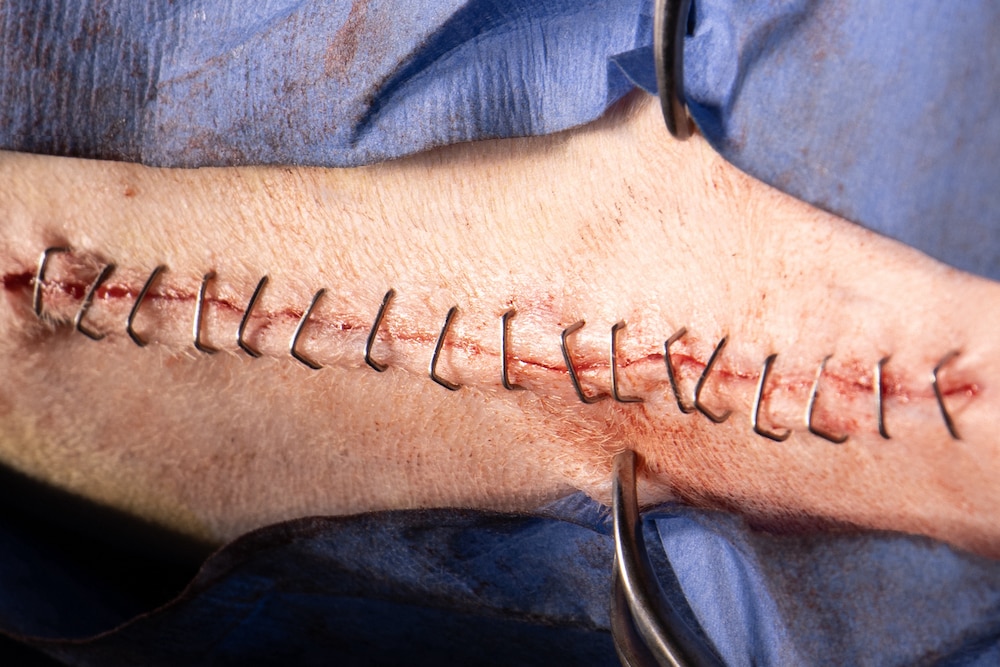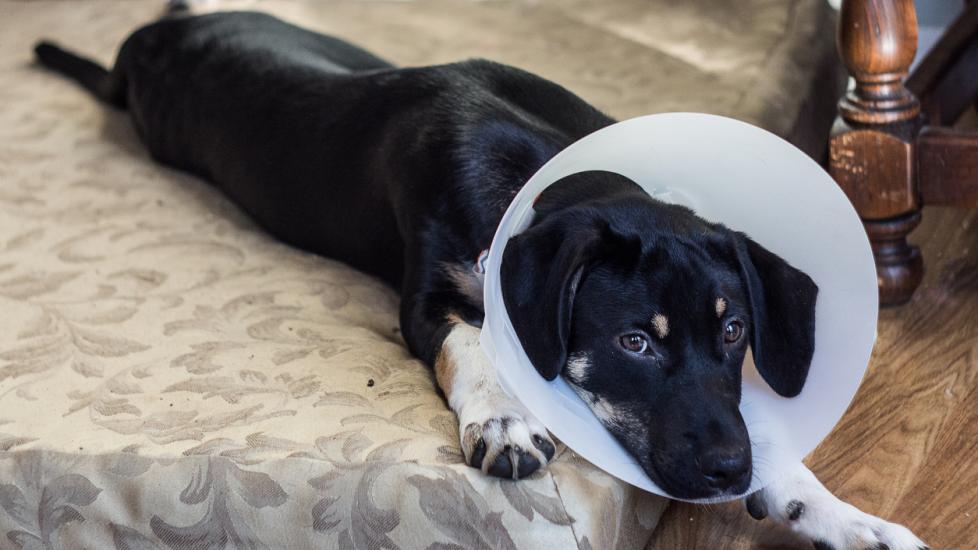How to Check Your Pet’s Stitches After Surgery
After your dog or cat undergoes surgery, the recovery period begins. A big factor of your pet’s recovery is caring for their incision. When you pick up your pet from the veterinarian's office, ask your vet or veterinary staff to show you your pet’s incision.
This will give you a baseline for what the incision looks like and help you to identify when something looks unusual. Take a picture of the incision on day one and each day after to track the healing process.
The veterinary team will give you discharge instructions to follow, such as restricting your pet’s activity, when to return for rechecks, and when or if the sutures (aka stitches; many vets use these words interchangeably) need to be removed.
Depending on the incision type and location, your veterinarian may have used a single type of suture or a combination of products to close your pet’s skin incision, including absorbable sutures, nonabsorbable sutures, staples, or tissue glue. Be sure to ask which type your vet used so you can know what to expect and look for during recovery.
Types of Sutures
Internal Stitches (Absorbable)
Internal stitches are placed underneath the skin. They are (generally speaking) absorbable, meaning that over time, the stitches will break down on their own and dissolve. Unless complications occur, internal stitches do not need to be removed.
If your dog has only internal stitches and you notice visible stitches or any openings in the skin, reach out to your veterinarian for care recommendations.
External Stitches
External stitches are placed on the outside of the skin. These stitches will need to be removed after the skin heals, typically 10-14 days after surgery. A veterinary professional will assess the incision to ensure that it’s fully healed before the external stitches are removed.
Staples
Surgical staples are generally made from surgical steel and placed as the outermost layer in a surgical incision. Staples are a fast and secure way to close a portion of an incision. They are removed once healing is complete, typically 10-14 days after surgery. Removal requires a special staple-removal clamp. Removal of surgical staples is just as easy and pain-free as the removal of sutures.

Staples on a pet's abdomen after surgery (Photo credit: Sandra Mitchell, DVM)
Glue
Tissue glue, sometimes called liquid stitches, may be used on its own to close a very small incision or as an additional measure to help close a larger incision. Glue does not need to be removed.
Healing Timeline and Stages
There are three main phases of incision healing: inflammation, repair, and maturation.
Inflammation Stage
Inflammation starts immediately after the incision is made. The body starts to attempt to control bleeding by encouraging blood clots and constricting blood vessels along the cut edges of the incision. The immune system is then mobilized, and white blood cells enter the area to help prevent infection and promote wound healing.
The incision in this stage may be pink or light red, and there may be bruising in the area. Early on, the incision may have a very light amount of clear to slightly bloody discharge.
Repair Stage
The repair stage (also known as the proliferation stage) starts approximately 4-6 days after surgery and continues for another 1-2 weeks. The cells in the incision area divide to rebuild damaged tissues. They also produce new tissue (granulation tissue) that will close over the incision.
The incision should be normal in skin color or light pink, and bruising should be faint or gone. Scabbing should also be minimal, and there should not be any discharge.
Maturation Stage
Maturation occurs weeks after surgery, when granulation tissue and collagen are transformed into scar tissue. New scar tissue is thin and fragile and can take a few weeks to gain strength.
All redness and scabbing should be resolved, and the skin should appear normal with scar tissue where the incision was. Hair will take up to 3 months to start to grow back.
How to Care for Your Pet’s Incision Site
The most important thing that you can do after your pet's surgery is to follow your veterinarian's post-op instructions. These are the most common guidelines for sutures:
Restrict Your Pet’s Activity
Most pets will require some form of activity restriction after surgery. As most incisions take around 10-14 days to heal, your pet will need to take it easy for at least that long. Activity restriction may range from strict crate rest to allowing only leash walks. Too much movement around an incision can lead to delayed healing, inflammation, fluid accumulation in the incision, or premature breakdown of the stitches.
Keep the Cone (Elizabethan Collar) on Your Pet
Licking the area can cause infection, inflammation, or irritation at the incision site and may also damage the sutures. If your pet’s sutures are in a location that they can chew or lick, your veterinarian may recommend that they wear a cone, also called an Elizabethan collar or e-collar.
Depending on the location, your veterinarian may instead recommend a surgical recovery suit. Other pets in your household may also try to lick the incision. If this happens, you may need to separate the two pets or have the pet that’s doing the licking wear a cone as well.
Follow Your Vet’s Instructions for Treating the Area
Most incisions do not require any topical treatment, but you will need to ensure that your pet's incision always stays clean and dry. If your veterinarian directs you to clean the incision or apply any medication, follow their recommendations exactly.
Give Your Pet Any Prescribed Medications
Your veterinarian may prescribe antibiotics, anti-inflammatories, or pain medications to give your dog or cat during their recovery. It is important to give these medications as directed.
Check Your Pet’s Stitches Daily for Signs of Infection or Other Issues
Monitoring your pet's incision daily will help you to notice any changes early. If your pet wants to lick or scratch the incision, you may want to monitor the area more frequently.
It is very common for pets that undergo routine spay or neuter procedures to have all-internal stitches. The knots the veterinarian places in the suture material may cause small bumps at the beginning and end of the incision. These bumps will recede with time and should eventually disappear as the suture material dissolves.
Bruising can also be present at the incision site. Bruising may worsen over the first 24 hours after surgery but should then improve. Bruising may spread slightly but should lighten over time. It is normal for bruising to change in color and may appear red to various shades of purple. However, if you notice new bruises or that the bruising is getting darker, tell your veterinarian immediately.
It can be normal for there to be a very small amount of light red discharge from your pet's incision for the first several hours after surgery. However, if the amount of discharge increases or changes in color to dark red (blood), yellow, white, or green, the area may be infected, and your pet should be seen immediately.
Here are some signs of problems to check for daily:
Infection
Infections at a surgery site should always be taken seriously. Signs include:
-
Redness: dark pink or red skin
-
Swelling: warm, swollen, or painful area around the incision
-
Discharge: bloody, clear, milky, yellow, or green
-
Pet seems stiff or reluctant to move
-
Sudden decrease in appetite
-
Vomiting and diarrhea
Openings or Missing or Damaged Stitches
Sutures can come undone, especially if a pet has been overly active or licking their incision. If you notice any missing stitches; loose, untied sutures; or gaping or openings at the incision site, contact your veterinarian right away.
Suture Reactions With Internal Sutures
For pets that had internal (absorbable) sutures, another issue may appear weeks to months after an incision has healed. This is called a suture reaction. Suture reactions take place as the absorbable suture material breaks down.
In a small number of pets, the absorbable suture material causes a reaction from the pet's immune system, leading to inflammation in the incision. This is most likely to occur in areas of highest suture material concentration, like in the knots that are often placed at the top and bottom of the incision.
This may feel like a firm bump, which can be normal, but if you notice that the bump is swollen, or there is a pimple-like bump on the incision line, or there’s any drainage, then this reaction needs to be addressed by your veterinarian.
Most pets require that the area is kept clean, and many pets will be placed on anti-inflammatory medications until all redness and irritation has resolved.
Rarely, if an infection is present, your pet may need to be placed on antibiotics or have the remaining suture material in the incision removed.
Guides for spay and neuter aftercare and recovery:
Featured Image: iStock.com/benjaminjk
